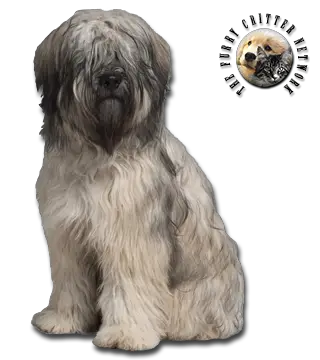Breed Standard
Head: Strong, slightly convex. Pronounced stop. Straight, short forehead. Cone-shaped muzzle.
Ears: Set on high. Fine leather. Drop, triangular ending in a point. Cropped ears are acceptable for working dogs.
Eyes: Round. Dark amber eyes. Black rims.
Body: Strong with length being slightly greater than height. Deep chest. Ribs well sprung. Straight back. Powerful, slightly sloped croup.
Tail: Attached low. Long or short (maximum length 10 cm). Some varieties are naturally tailless. Docked tail is permitted for working dogs. Hangs in a hook when relaxed. Richly clad with hair.
Hair: Long, flat, and rough. Thick undercoat. Full beard, mustache, forelock, and fall. Seasonal shedding occurs in two stages, beginning with the front half of the body, followed by the back half of the body.
Coat: Color created by a mixture of hairs of various shades – fawn, reddish-brown, gray, black, and white. The base colors are fawn, gray, and sable.
Size: Dog: 47 to 55 cm.Bitch: 45 to 53 cm.
Weight: Dog: approx. 18 kg.Bitch: approx. 16 kg.
History
This breed came from Catalonia, Spain. It is presumed that he is descended from the ancient Pyrenees sheepdogs. During the Spanish Civil War, the Catalan Sheepdog served as messenger and sentry.
Einstein in the Back to the Future trilogy, is a Catalan sheepdog.
Behavior
The Catalan Sheepdog is courageous, intelligent, and energetic. His greatest traits shine through when herding; not only is he obedient to the commands of his handler, but he often takes the initiative, directing the sheep with remarkable ease. This brave, alert breed also makes an excellent guard dog. As a pet, he is loyal and gentle with children. This breed is well adapted to living outdoors.
This breed is used for herding and as a pet dog. Because of its intelligence, the Gos D'Atura, like most sheepdogs, is easy to train. This cheerful dog excels at dog-sports, such as agility and doggy-dance. In spite of its appearance, this courageous dog is also used as a watch-dog. An "all-around-dog" and great companion.
They guard sheep without needing instruction. Enough (outdoor) activity and distraction makes this dog a quiet and well-balanced home companion. This breed is appropriate for people with firm techniques and who can give the dog enough exercise. Early socialization is important, particularly if the dog will be around children. The dogs defend their family and become very attached to it.
While this dog can live indoors, he needs a lot of exercise. Daily brushing is required.
Function
Sheepdog (guard and herder), Guard Dog, Police Dog, Agility Dog, Pet.
Health
Catalan sheepdogs are prone to hip dysplasia.






